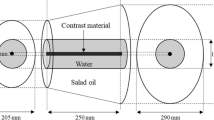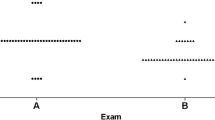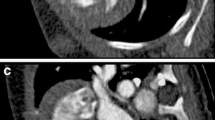Abstract
To evaluate the radiation dose and image quality of 100 kVp cardiac CT, and the effects of display setting optimization. We randomly assigned 100 patients undergoing cardiac CT to one of following two protocols. Fifty patients underwent our conventional protocol with 120 kVp, and the other 50 patients underwent our low radiation dose protocol with 100 kVp. We compared effective dose (ED); CT number, image noise, and contrast noise ratio (CNR) of ascending aorta at 120 and 100 kVp protocol. We also performed quantitative analysis and qualitative analysis for bitmap image of 120, 100 kVp, and display preset optimization for 100 kVp images. The estimated ED was 48 % lower with the 100 kVp protocol than the 120 kVp protocol (2.8 vs. 5.5 mSv, p < 0.01). There is no significant difference in the CNR between 100 and 120 kVp protocol (18.5 ± 3.6 vs. 18.6 ± 3.8, p = 0.84). Display preset optimization significantly improved image quality of 100 kVp cardiac CT, and there is no significant difference in qualitative analysis and quantitative analysis between 100 kVp scan with optimized display preset and 120 kVp scan (p > 0.05). The 100 kVp scanning with optimized display preset offers almost same image quality at cardiac CT of thin adults under 48 % decreased radiation dose.



Similar content being viewed by others
References
Sodickson A, Baeyens PF, Andriole KP, Prevedello LM, Nawfel RD, Hanson R et al (2009) Recurrent CT, cumulative radiation exposure, and associated radiation-induced cancer risks from CT of adults. Radiology 251:175–184
Berrington de Gonzalez A, Mahesh M, Kim KP, Bhargavan M, Lewis R, Mettler F et al (2009) Projected cancer risks from computed tomographic scans performed in the United States in 2007. Arch Intern Med 169:2071–2077
Brenner DJ, Hall EJ (2007) Computed tomography: an increasing source of radiation exposure. N Engl J Med 357:2277–2284
Raff GL, Gallagher MJ, O’Neill WW, Goldstein JA (2005) Diagnostic accuracy of noninvasive coronary angiography using 64-slice spiral computed tomography. J Am Coll Cardiol 46:552–557
Scheffel H, Alkadhi H, Plass A, Vachenauer R, Desbiolles L, Gaemperli O et al (2006) Accuracy of dual-source CT coronary angiography: first experience in a high pre-test probability population without heart rate control. Eur Radiol 16:2739–2747
Juergens KU, Grude M, Fallenberg EM, Opitz C, Wichter T, Heindel W et al (2002) Using ECG-gated multidetector CT to evaluate global left ventricular myocardial function in patients with coronary artery disease. AJR Am J Roentgenol 179:1545–1550
Hausleiter J, Meyer T, Hadamitzky M, Huber E, Zankl M, Martinoff S et al (2006) Radiation dose estimates from cardiac multislice computed tomography in daily practice: impact of different scanning protocols on effective dose estimates. Circulation 113:1305–1310
Mollet NR, Cademartiri F, van Mieghem CA, Runza G, McFadden EP, Baks T et al (2005) High-resolution spiral computed tomography coronary angiography in patients referred for diagnostic conventional coronary angiography. Circulation 112:2318–2323
Bischoff B, Hein F, Meyer T, Hadamitzky M, Martinoff S, Schomig A et al (2009) Impact of a reduced tube voltage on CT angiography and radiation dose: results of the PROTECTION I study. JACC Cardiovasc Imaging 2:940–946
Hausleiter J, Martinoff S, Hadamitzky M, Martuscelli E, Pschierer I, Feuchtner GM et al (2010) Image quality and radiation exposure with a low tube voltage protocol for coronary CT angiography results of the PROTECTION II Trial. JACC Cardiovasc Imaging 3:1113–1123
Ripsweden J, Brismar TB, Holm J, Melinder A, Mir-Akbari H, Nilsson T et al (2010) Impact on image quality and radiation exposure in coronary CT angiography: 100 versus 120 kVp. Acta Radiol 51:903–909
Park EA, Lee W, Kang JH, Yin YH, Chung JW, Park JH (2009) The image quality and radiation dose of 100 versus 120-kVp ECG-gated 16-slice CT coronary angiography. Korean J Radiol 10:235–243
Wintermark M, Maeder P, Verdun FR, Thiran JP, Valley JF, Schnyder P et al (2000) Using 80 versus 120 kVp in perfusion CT measurement of regional cerebral blood flow. AJNR 21:1881–1884
Sigal-Cinqualbre AB, Hennequin R, Abada HT, Chen X, Paul JF (2004) Low-kilovoltage multi-detector row chest CT in adults: feasibility and effect on image quality and iodine dose. Radiology 231:169–174
Nakayama Y, Awai K, Funama Y, Hatemura M, Imuta M, Nakaura T et al (2005) Abdominal CT with low tube voltage: preliminary observations about radiation dose, contrast enhancement, image quality, and noise. Radiology 237:945–951
Ertl-Wagner BB, Hoffmann RT, Bruning R, Herrmann K, Snyder B, Blume JD et al (2004) Multi-detector row CT angiography of the brain at various kilovoltage settings. Radiology 231:528–535
Waaijer A, Prokop M, Velthuis BK, Bakker CJ, de Kort GA, van Leeuwen MS (2007) Circle of Willis at CT angiography: dose reduction and image quality–reducing tube voltage and increasing tube current settings. Radiology 242:832–839
Lev MH, Farkas J, Gemmete JJ, Hossain ST, Hunter GJ, Koroshetz WJ et al (1999) Acute stroke: improved nonenhanced CT detection–benefits of soft-copy interpretation by using variable window width and center level settings. Radiology 213:150–155
Nakaura T, Awai K, Oda S, Funama Y, Harada K, Uemura S et al (2011) Low-kilovoltage, high-tube-current MDCT of liver in thin adults: pilot study evaluating radiation dose, image quality, and display settings. AJR 196:1332–1338
Cademartiri F, Nieman K, van der Lugt A, Raaijmakers RH, Mollet N, Pattynama PM et al (2004) Intravenous contrast material administration at 16-detector row helical CT coronary angiography: test bolus versus bolus-tracking technique. Radiology 233:817–823
Bongartz G, Golding SJ, Jurik AG, Leonardi M, van Persijn van Meerten E, Rodriguez R, Schneider K, Calzado A, Geleijns J, Jessen KA, Panzer W (2004) European guidelines for multislice computed tomography: appendix C. Funded by the European Commission: Contract No. FIGM-CT2000-20078-CT-TIP
Funama Y, Awai K, Nakayama Y, Kakei K, Nagasue N, Shimamura M et al (2005) Radiation dose reduction without degradation of low-contrast detectability at abdominal multisection CT with a low-tube voltage technique: phantom study. Radiology 237:905–910
Nakayama Y, Awai K, Funama Y, Liu D, Nakaura T, Tamura Y et al (2006) Lower tube voltage reduces contrast material and radiation doses on 16-MDCT aortography. AJR 187:W490–W497
Schueller-Weidekamm C, Schaefer-Prokop CM, Weber M, Herold CJ, Prokop M (2006) CT angiography of pulmonary arteries to detect pulmonary embolism: improvement of vascular enhancement with low kilovoltage settings. Radiology 241:899–907
Huda W, Scalzetti EM, Levin G (2000) Technique factors and image quality as functions of patient weight at abdominal CT. Radiology 217:430–435
Huda W, Ogden KM (2004) Optimizing abdominal CT dose and image quality with respect to X-ray tube voltage. Med Imaging 5368:499–507
Mahesh M. MDCT Physics the basics: technology, image quality and radiation dose
Bae KT (2010) Intravenous contrast medium administration and scan timing at CT: considerations and approaches. Radiology 256:32–61
Hurwitz LM, Yoshizumi TT, Goodman PC, Frush DP, Nguyen G, Toncheva G et al (2007) Effective dose determination using an anthropomorphic phantom and metal oxide semiconductor field effect transistor technology for clinical adult body multidetector array computed tomography protocols. J Comput Assist Tomogr 31:544–549
Conflict of interest
None.
Author information
Authors and Affiliations
Corresponding author
Rights and permissions
About this article
Cite this article
Nakaura, T., Kidoh, M., Sakaino, N. et al. Low radiation dose protocol in cardiac CT with 100 kVp: usefulness of display preset optimization. Int J Cardiovasc Imaging 29, 1381–1389 (2013). https://doi.org/10.1007/s10554-013-0214-x
Received:
Accepted:
Published:
Issue Date:
DOI: https://doi.org/10.1007/s10554-013-0214-x




